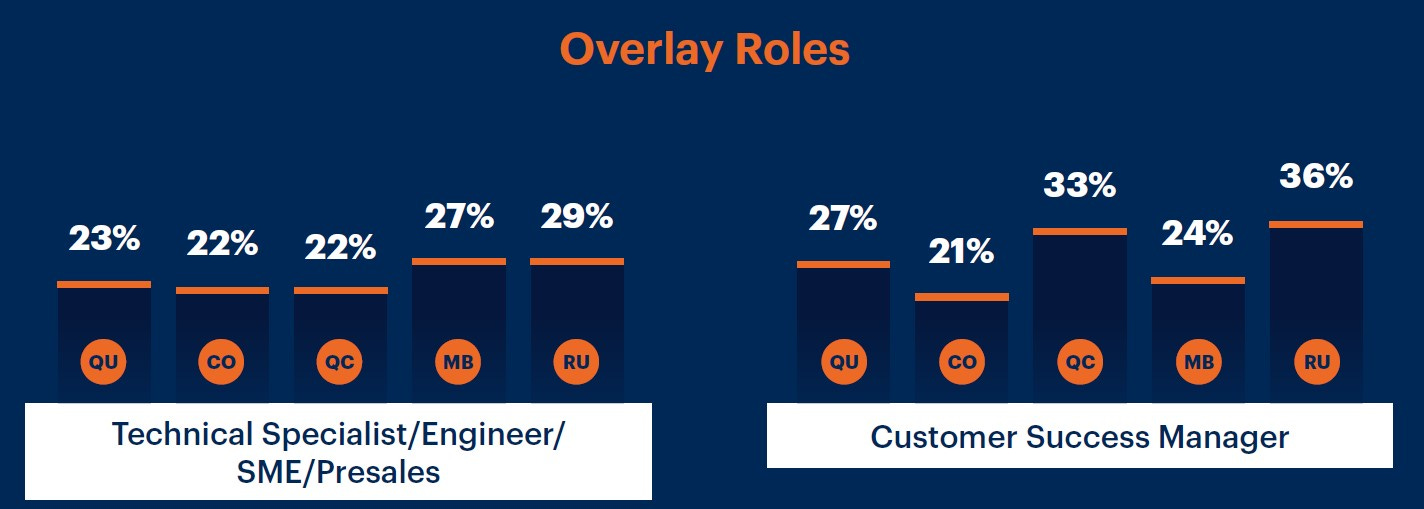Sales role names and descriptions: what if we were more Customer-centric?
And why?
In our Sales Compensation Strategy article, we referred to several types of roles and functions. Here, we’ll provide clear descriptions of the main ones to give you deeper insight. Then, we’ll do something a little unconventional: put ourselves in the shoes of the customer.
Notes:
These definitions aren’t set in stone, so there should be flexibility and room for variation.
If we had included these definitions in the main article, it would have been a bit too long. We know you.
Role Descriptions
Hybrid Account Manager
A Hybrid Account Manager blends responsibilities from both an Account Manager (farmer) and an Account Executive (hunter). This role involves managing existing client relationships, ensuring customer satisfaction, and identifying new business opportunities within those accounts. The individual is responsible for renewing contracts, managing ongoing business, and seeking growth or upselling opportunities.
Strategic Account Manager
A Strategic Account Manager focuses on high-value, long-term clients with significant revenue potential or strategic importance. This role requires deep relationship-building, tailored solutions, and a proactive approach to maintaining customer loyalty. They work closely with key clients to understand their business needs and ensure the company’s offerings align with those needs to drive mutual success.
Inside Sales Representative
An Inside Sales Representative works primarily from the company’s office, handling sales activities via phone, email, or other digital channels. This role focuses on lead generation, qualifying prospects, and nurturing relationships until they are ready for more in-depth discussions. Inside Sales Representatives often deal with smaller, more transactional sales compared to field sales and may support other salespeople in closing deals.
Business Development Representative (BDR)
A Business Development Representative identifies new business opportunities and generates leads, usually at the top of the sales funnel. BDRs focus on prospecting, qualifying, and setting appointments with potential clients. Unlike an Account Executive (hunter), who actively closes deals, BDRs collaborate with Account Executives or sales teams to hand off qualified leads for follow-up and closure.
Account Executive (Hunter)
An Account Executive (Hunter) is focused on acquiring new clients or customers. Their main role is to seek out and pursue new business opportunities through cold calling, networking, and other lead generation tactics. Once a potential customer is identified, the hunter works to close deals, often engaging in negotiations and pitching the company’s products or services to win the business.
Account Manager (Farmer)
An Account Manager (Farmer) manages and nurtures existing customer relationships. Unlike acquiring new business, the farmer’s role is focused on customer satisfaction, client retention, and identifying opportunities to expand within existing accounts (such as upselling or cross-selling). Farmers work to maintain long-term relationships and are responsible for renewals, ensuring customers continue to derive value from the company’s products or services.
In the shoes of your Customer
If you've been following me for a while, you’ll know I don’t particularly like any of the titles mentioned above (you can read Salespeople Are Dead; Long Live Salespeople! for more insight). The primary reason is that these terminologies are internally-focused. While the core objective of any sales organization should be the customer, these titles suggest otherwise. They reflect our internal perspective rather than addressing what the customer truly needs and cares about. Let me explain.
Take the title “Strategic Account Manager” as an example. If someone is handling my account but isn't labeled as “Strategic,” does that mean I’m not an important or "strategic" customer? How should I feel about that? What about the title “Hybrid Account Manager”? Does that imply the rep is part human, part dolphin? As a customer, would I rather be “managed,” or would I prefer to be advised, supported, heard, and helped?
You might think I’m exaggerating, but these names often don’t resonate well with customers. Worse yet, they may even set off alarm bells: "Sales Rep ahead, block the door." Think about it—if you were a customer, would it matter if someone was an “Inside Sales Representative” or an “Outside Sales Representative”? Would you care if that person is stationed inside or outside the office? The real question should be: How well does this person understand my needs and solve my problems? As a customer, do I really want to deal with someone whose primary focus is to sell, or would I rather work with someone who’s dedicated to helping me?
Keep in mind that at Apple Stores, there is no such thing as “Salespeople,” yet their revenue per square meter is among the highest in the retail industry. This speaks volumes.
Meanwhile...
In many organizations, you’ll find roles with titles like “Customer Success Manager,” “Customer Advocate,” “Client Relationship Manager,” “Customer Care Representative,” and “Client Success Manager.” These titles sound music to my ears. Ironically, most of these roles don’t belong to the sales organization, and if they do, only a minimal part of their salary is variable.
According to Gartner’s study on compensation, “Benchmark Your Sales Compensation Strategy for Success,” the most popular incentive plan for these roles is based on a Roll-Up (RU) model. This means their compensation is tied to the aggregated performance of others. (More here: The power of Sales Compensation: how incentives drive results)
It’s important to note that everyone is selling something to someone. However, some industries better understand what their reps are offering to their customers than others. Do you really believe that consultants are not salespeople? What about real estate brokers, financial advisors, or headhunters? They are offering expertise in exchange for payment. Isn’t that exactly what your reps are doing? Aren’t you asking them to be experts in their industry so they can confidently “present at the CxO level”? (A very common skill requested in most sales roles.)
And just because you change their titles to better represent their role to customers (and potentially shift their own mindset) doesn’t mean they’ll forget about their quotas and targets. After all, your entire internal structure is designed to keep reminding them of it.
In conclusion
As we highlighted in the Sales Compensation Strategy article, how you incentivize your people will determine the outcomes you can expect. Similarly, you should carefully consider how you present and introduce your people to the outside world. Keep your internal organizational structure to yourself and focus on how you want to present your team and your company to customers. This approach will undoubtedly differentiate you from many of your competitors.



